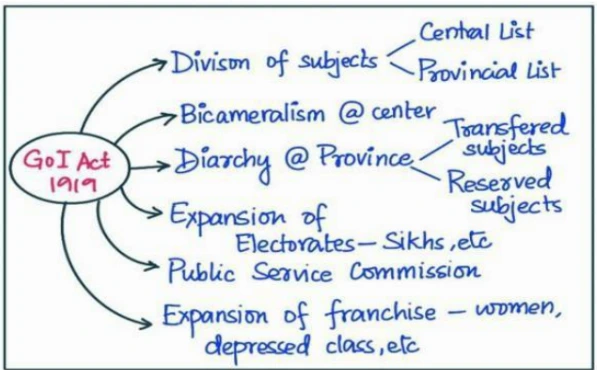Answer:
|
How to approach the question
- Introduction
- Write briefly about the Government of India Act 1919.
- Body
- Write about the clauses of the Government of India Act 1919.
- Write about the criticism of the Government of India Act 1919.
- Conclusion
- Give appropriate conclusion in this regard.
|
Introduction
The Government of India Act 1919, also known as the Montagu-Chelmsford Reforms, was introduced to address the growing demands for political reforms and limited self-government in India.
Body
Clauses of the Government of India Act 1919
- Two lists of administration: It provided two lists of administration, i.e. Central list and Provincial list.
- Bicameral legislature at centre: With Council of State and Central Legislative Assembly. Also, The Act increased the size of the Central Legislative Council and expanded the representation of Indians. The Council had both elected and nominated members, with the majority of members being nominated.
- Dyarchy: The act established a dual system of governance at provincial level, dividing subjects into reserved and transferred areas. The reserved subjects were under the exclusive control of the Governor, who was appointed by the British authorities, while the transferred subjects were administered by the Governor with the help of ministers responsible to the legislative council.
- Responsibility of provincial ministers to legislature: It introduced the responsibility of the provincial ministers over the transferred subjects.
- Separate Electorates: The act expanded the system of separate electorates based on religion to Sikhs, Anglo Indians, Europeans etc. other than Muslims.
- Public Service Commission: It was established to regulate the recruitment and appointment of civil servants and ensure a fair and impartial selection process.
- Franchise Expansion: It extended the franchise to a limited number of people, including a wider group of property owners, educated individuals, and professionals.
- Control over Revenue: The Act gave the provincial governments control over their revenues and allowed them to levy certain taxes. This provision aimed to grant some financial autonomy to the provinces.
- Separation of Functions: The Act separated the executive and legislative functions. The executive authority was vested in the Governor, while legislative functions were performed by the Legislative Councils.
Criticism of the Government of India Act 1919
- Failed to fulfil nationalist aspirations which were aroused by the August 1917 declaration.
- Large number of nominated members undermined popular sovereignty.
- Allocation of seats to provinces to the central legislative assembly was based on their importance,
e.g. Punjab’s military importance, Bombay’s commercial importance.
 Dyarchy related issues: It led to frequent clashes between elected and appointed officials, creating a cumbersome decision-making process.
Dyarchy related issues: It led to frequent clashes between elected and appointed officials, creating a cumbersome decision-making process.- Limited franchise: For example, only a small percentage of Indians had the right to vote, based on property qualifications.
- Insufficient representation: The majority of members in the councils were still appointed by the British government rather than being elected by the Indian public.
- Retention of key powers: The British government retained significant control over crucial areas such as defense, finance, and administration.
- Communal representation: The provision of communal representation led to the polarization of society along religious lines.
- Centralized structure: The Act maintained a centralized structure of governance, limiting the devolution of power to local governments and impeding grassroots democracy.
Conclusion
Overall, the 1919 Government of India Act brought about important changes that increased Indian participation in governance, devolved power etc. While the Act fell short of full self-governance, it laid the foundation for future constitutional developments in India.
To get PDF version, Please click on "Print PDF" button.
 Dyarchy related issues: It led to frequent clashes between elected and appointed officials, creating a cumbersome decision-making process.
Dyarchy related issues: It led to frequent clashes between elected and appointed officials, creating a cumbersome decision-making process.
Latest Comments